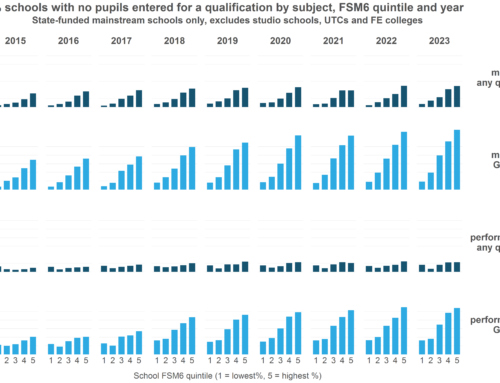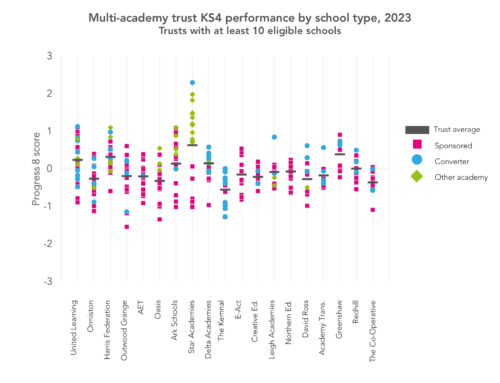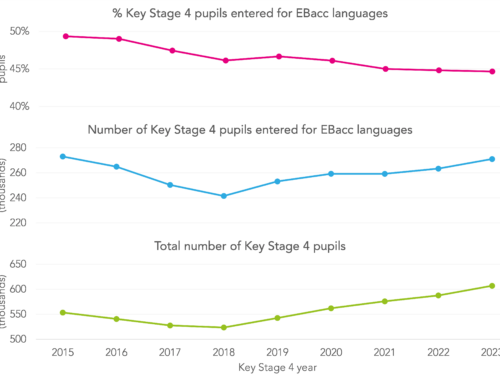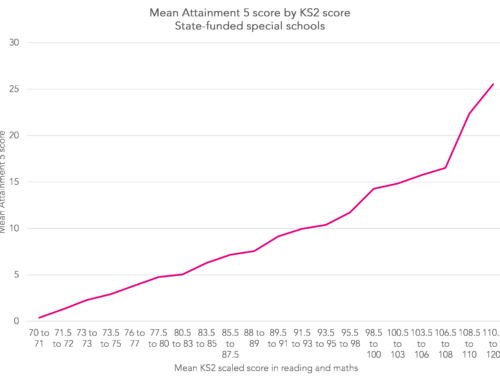On 13 October secondary schools will receive Progress 8 data for 2016. They will already have received so-called ‘shadow’ data for 2015, of course, but the 2016 data will be different. It will be a game changer. It will be published in Performance Tables and used to define floor standards. As we have written previously, it is a massive step forward on previous headline performance measures but, as with all measures used for high-stakes accountability, has issues of fairness for certain types of school.
In this post I focus on what Progress 8 will mean for some of those types of school. In particular, the new class of schools which admit pupils at age 14, University Technical Colleges (UTCs) and studio schools.
Schools below the floor
We have calculated our own internal Progress 8 measures for a number of years now. If we were to apply the 2016 floor standard (a Progress 8 score of -0.5 or lower) to 2015 data then just over 10 per cent of state-funded schools would have been below the floor. However, this percentage was much higher at 65% and 90% among UTCs and studio schools respectively.
Schools below the 2016 floor based on 2015 Progress 8 data
| % below floor | Number below floor | Total | |
| Community schools | 11% | 65 | 602 |
| Voluntary aided/controlled schools | 5% | 16 | 327 |
| Foundation schools/CTCs | 16% | 47 | 300 |
| Converter academies | 3% | 40 | 1272 |
| Sponsored academies | 25% | 125 | 503 |
| Free schools | 21% | 4 | 19 |
| University Technical Colleges | 65% | 11 | 17 |
| Studio schools | 90% | 19 | 21 |
| Total | 11% | 327 | 3061 |
It is perhaps unsurprising that so many studio schools fell below the floor as their curriculum is not fully aligned to Progress 8. On average pupils filled 1.6 of the EBacc ‘buckets’ compared to a national average of 2.4. The figures for UTCs are more surprising though. The curriculum is reasonably well-aligned with pupils filling 2.4 of the EBacc ‘buckets’, exactly in line with the national average, yet the Progress 8 scores of many UTCs are poor.
(It is also noteworthy that so many free schools and sponsored academies fall below the floor. I suspect that Progress 8 will raise the temperature of the debate about academies.)
What about FE colleges?
It is unclear (to me at least) whether Progress 8 will be published for FE colleges. I suspect not. However, since 2013 they have been able to enrol 14 to 16-year-olds into full-time study. In 2015 data was published in Key Stage 4 performance tables for the first five adopters of this policy. The initial results were not promising. Just six per cent of 250 pupils achieved 5 or more A*-C grades including English and maths.
Headline KS4 performance 2015, FE Colleges with full-time KS4 pupils

Progress 8 scores for each of these colleges in 2015 would also have been below the 2016 floor standard. Should they be included in Progress 8? On the one hand no, given that they are delivering a different type of curriculum to that encouraged by Progress 8. On the other hand yes, given that they are receiving public funding for the education of 14 to 16-year-olds and so should be subject to the same accountability regime as schools.
More pertinently, how are decisions made about transfers at age 14? If they are made in the best interests of pupils who wish to pursue a particular type of curriculum then there is no problem. However, if these routes become a mechanism that enable schools to move on pupils most likely to make poor progress simply to improve their own performance measures then we need to think again about holding schools to account for all their pupils, not just those who make it to the end of Year 11.






In view ofthe current furore over grammar schools, one wonders how many of them fall below the floor.
None fell below the official floor in 2015 but one would have done so if Progress 8 had been used. Would be surprised if that’s still the case when 2016 data becomes available.
Thank you Dave, interesting post. There are likewise issues with those pupils going the opposite way – ie, not arriving aged 14 but actually leaving mainstream secondaries aged 14 (and 15) to start AP/PRU provision, with many (perhaps most?) not included in the secondary Performance Tables.
Thanks Dan. Yes that’s right. We looked at this briefly in a previous blog post http://ffteducationdatalab.org.uk/2016/01/schools-should-be-held-accountable-for-all-the-pupils-they-teach/
With regard to UTCs, the IPPR report suggests they are more likely to either be under-performing themsleves at KS3, or transferring from under-performing schools. Therefore, since P8 covers KS3 and KS4 progress, and the UTCs only influence KS4 progress, the impact of the skewed entry profile at 14 may explain some of the poor P8 performance. I don’t suppose that will save the UTCs that fall below floor standard although it does give them a straw to grasp – or rather wave at Ofsted. The argument might hold more water if used against any attempt to use UTCs’ performance to respond to the Green Paper.